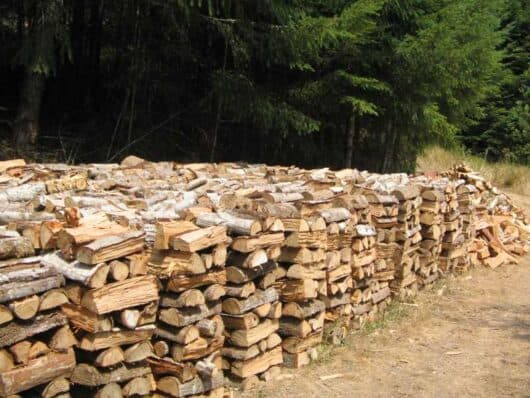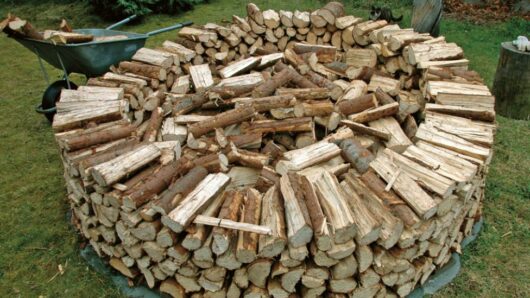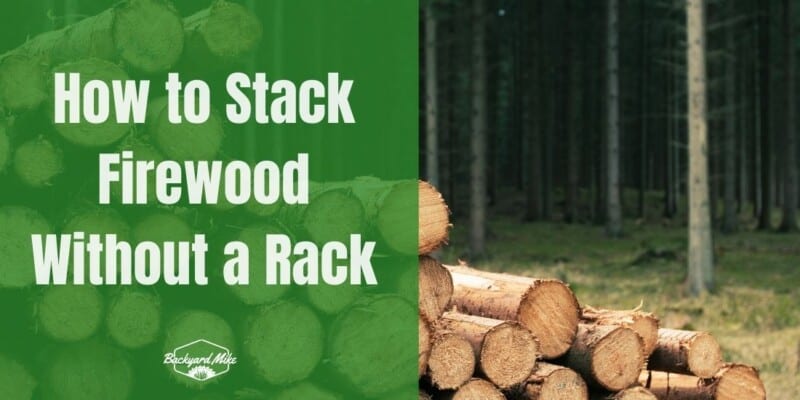Stacking firewood is a tricky task that requires skill and patience. Anyone who has ever tried to stack firewood without a rack knows that it is often a tedious and time-consuming process. But don’t worry – we’ve got you covered! In this article, we’ll provide you with expert tips and tricks on how to stack firewood without a rack. So, get out your wood and let’s get started! You’ll be stacking firewood like a pro in no time.
Overview of stacking firewood
Nothing celebrates the cold winters like the scent and sound of a crackling log in your wood-burning fireplace. A steady supply of firewood could help offset your heating costs. Unlike oil or coal, firewood is a renewable resource that can be replanted for future use. When you’re splitting wood, you cannot just stack firewood in any way. There is a specific way to stack firewood and it includes using a rack. However, there, it is also possible to stack firewood without a rack.
To stack cords of wood without using a rack, you will have to build something to contain and stabilize the wood pile. You need to make wood columns using firewood on either end of the wood pile. If you do this the right way, they will act as regular columns and stabilize the whole pile.
How to stack firewood without a rack
- Lay down equal-sized pieces of wood side by side before laying them side by side in the opposite direction
- Test the stack as you’re building to ensure it isn’t rickety (when you’re pushing on the wood, there shouldn’t be any wiggling)
- Continue to do so until the stack is 4 feet high.
- Fill any gaps in the column with smaller pieces of wood for creating a sturdier structure
- Repeat the same process on the other end where the wood pile will be (there must be a space of around 7 feet between the columns)
- You can easily make the columns anywhere from 4–5 feet high, and they will be unlikely to fall down
- Once you’ve made the wood columns, you’ll be able to stack your firewood in between
Other ways to stack and store firewood without a rack
#1. Choose a location for storing the firewood
Before you start building the wood pile, you will need to pick the ideal spot for storing the firewood. You might be tempted to keep the wood stack near your home. After all, you would not want to walk that far in the snow or rain to gather fuel for burning firewood. Moreover, the eaves of your roof will provide shelter against the rain and snow. But this isn’t necessarily the ideal situation.
If you reside in an area prone to wildfires or dry conditions, a seasoned firewood stack close to your house could be a serious fire hazard. If you’re storing wood directly against your home or cabin, the moisture can be trapped between the wood and the building. This can result in issues such as mildew, discoloration, or rot on the siding.
Moreover, unpleasant critters like termites prefer making a cozy home in dead wood. They can wreak havoc on your house’s foundation, porch, wood deck, or other nearby structures if they are placed close to those areas.

It is possible to avoid costly damage by storing the firewood at a certain distance from your house. It is recommended that you should have your wood stack at least 5 feet away from your house, or 30 feet if you’re living in a region prone to wildfires.
You must consider the layout of the landscape too when you’re choosing a location for storing the firewood. If your house is on a slope, you may want to make sure that the firewood stack is placed at the top of the stop. This way, you can prevent moisture from draining under the stack once it has rained or snowed.
You must avoid storing the firewood stack in the shade and look for an area that receives a lot of sunlight. The heat and light from the sun will naturally speed up the drying and seasoning process. This way, you will have better burning firewood for the cozy fall or winter evenings.
#2. Stack the firewood off the ground
When you’re creating the firewood pile, it’ll be key to keep the firewood stack off the ground. The bottom layer of the log pile will have to be a stable base. If the wooden logs are placed directly on the ground, they’ll be at a greater risk of developing moisture building. This could cause the wood to rot.
You shouldn’t waste the wood or have your entire work come crumbling down by keeping the wood’s bottom layer elevated and off the ground. This can be done easily by laying down multiple wood boards to rest the logs on. These types of wooden boards are designed in a way to be on the ground and resist moisture much better than natural wood.
#3. Stack the firewood outside
When you’re stacking the firewood with or without a rack, you will want to ensure that you aren’t stacking it way too tightly. If you stack the logs too tightly, it may prevent moisture to evaporate from your logs. Further, they won’t dry out or season as expected. You’ll want to make sure that there is enough space between the logs to promote airflow so that you can keep the wood nice and dry. When you’re stacking firewood, ensure that the ends are even, such that the wood pile is stable.
#4. Protect against external elements
If you have created the perfect wood pile, look to make sure that it stays nice and dry. It is especially important when it is outside. A tarp will provide the perfect cover for keeping moisture off of the firewood. However, the way you cover the firewood pile will be important.
You may think that enclosing the firewood pile in a tarp will help keep the firewood nice and dry. However, it can actually end up trapping moisture inside, which may prevent firewood from completely drying out.
Ideally, you’ll want to place the tarp on top of the pile of wood such that it covers the top rows of firewood. The water should run off the top over the trap rather than settling and soaking into the wood. For keeping the tarp attached to the wood pile, you could use a few bricks or patio pavers that you’ve got lying around. Then, place them on top of the tarp for keeping them from blowing away due to wood.
If a tarp isn’t available, you should place a few pieces of metal roofing on top of the woodpile. This will work in keeping the water off.

Expert tips and tricks for stacking firewood
While stacking firewood seems to be a simple task, it might not be as straightforward as some may think. There are numerous things to remember about how to stack firewood without a rack to ensure that seasoned wood lasts long and can be used as needed.
Here are a few expert tips and tricks that you must remember when stacking firewood –
- Make sure that you’re keeping the seasoned firewood dry
- If the wood you’ve stacked isn’t sheltered or covered, make use of a tarp for covering the top only such that the remaining portion of the wood can breathe
- Stack a couple of logs one way and another two logs the opposite way before adding wood to fill in the columns
- Square-cut logs or logs that are flat will be an ideal option for columns
- Round logs, having the largest ones on the bottom for added support, will work great in the main pile
- All wooden logs, whether they’re stacked in columns or placed in the main pile will have to be level, or you will risk them falling over
- For added safety when stacking wood, you should wear work boots that have steel toe protection
- An important thing for stacking the columns and the main pile would be to ensure they are level
- If the pile isn’t level, they could eventually topple over, it might not be today or in a few days, but they ultimately will
- Put weirdly shaped logs that do not fit into the file off to the side as these logs will make the wooden pile wobbly and once you have stacked up, you’ll be able to put the weird ones on top of the finished pile
FAQs
What is the best way to stack firewood without a rack?
When stacking firewood without a rack, it is important to create a stable base that is large enough to support the weight of the wood. Start by laying the logs in the desired direction, then use the largest logs to create the base. Add layers of smaller logs on top, staggering them for stability and alternating between horizontal and vertical stacking. Be sure to leave enough space between the logs for air to circulate.
What are the benefits of stacking firewood on a rack?
Stacking firewood on a rack has several benefits. It keeps the wood off the ground, which helps keep it dry and prevents it from getting wet or moldy. It also provides support and stability to the wood, making it easier to move when needed. Additionally, it helps to keep the logs organized and orderly, making it easier to access the wood when needed.
What are the different types of firewood racks?
There are several types of firewood racks available, including log racks, bin racks, and wall racks. Log racks are freestanding and can be used to store large quantities of firewood. Bin racks are typically smaller and can be used for both indoors and outdoors. Wall racks allow for easy storage in tight spaces and can be used to store up to approximately 1/4 cord of firewood.


